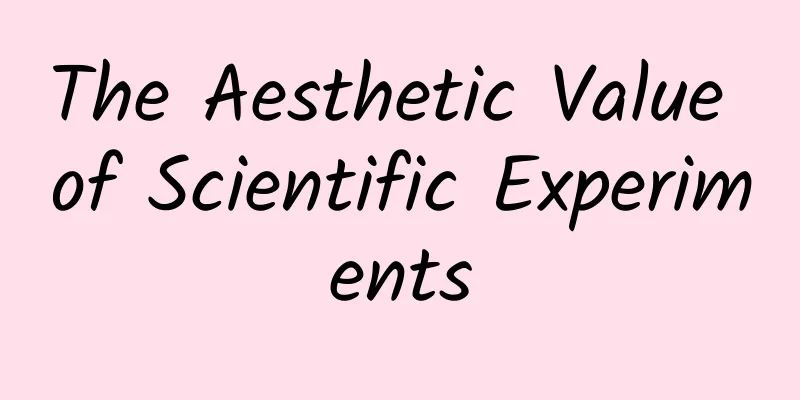The Aesthetic Value of Scientific Experiments

|
Today's scientific experimental devices are complex, and countless researchers conduct statistical analysis on large amounts of data, which makes scientific research contain collective wisdom. From the perspective of public understanding of science, early traditional scientific experiments were simpler and easier to demonstrate. But whether in the past or now, scientific experiments have aesthetic value, not only in visual perception, but also in understanding the world. By Milena Ivanova (Department of History and Philosophy of Science, University of Cambridge) Compilation | Bingma People tend to think that the beauty and elegance of scientific theories are important, but ignore the sophistication of device design in experimental research. The beauty in experimental design is also worthy of our attention. People create science, including theories, models, and experiments, to understand and change the world around them, and they are often praised as pleasing or beautiful. From scientific theories such as Einstein's theory of relativity and Darwin's theory of evolution to scientific experiments such as the discovery of electrons, DNA replication, and white light dispersion, scientific discoveries are not only praised for revealing the truth of the world, but the process of scientific discovery is also praised because it is so beautiful, concise, and exquisite. Just as people praise artists for their imagination and talent in creating new things, people also praise scientists for their artistic creativity while praising the aesthetic value of science. There is also an attractive artistic space in experimental science, but it is often overlooked. As we will see below, scientific experiments can be appreciated as art. Together with artworks, they can become public landscapes and evoke our aesthetic experience. The Aesthetics of Famous Scientific Experiments Looking back at the origins of experimental science, when natural philosophers in the 17th century demonstrated scientific experiments in public, experimental science was already labeled as an art. Experimental science, as an act of revealing or intervening in nature, was documented as early as the Novum Organum published in 1620, in which the author Francis Bacon emphasized the important contribution of experiments in forming hypotheses about the world and verifying the correctness of hypotheses. Experiments became the core of the empirical method of scientific research. With the help of new experimental instruments, coupled with continuous trial and repetition, natural philosophers were able to explore areas that had long been untouched and turn the unknown of the world into the known. During this period, scholars used the newly invented air pump to study vacuum; Newton used prisms to decompose natural light; and the advancement of optical devices and lenses promoted the development of new instruments, allowing scientists to go further in their research. For a time, these experiments became the key to understanding new inventions and the new discoveries that resulted from them. Joseph Wright's Experiment with Birds in the Air Pump, 1768 Joseph Wright (often called Joseph Wright of Derbyshire)'s famous painting "An experiment on a bird with the air pump" brilliantly depicts the performance art nature of the experiment itself, as well as the rich forms of the experiment in arousing the audience's aesthetic response. In the middle of the painting is the experiment operator, but he is more like a performer. He not only shows the experiment itself to the audience, but also plays the role of controlling the atmosphere of the scene, teasing the audience's emotions, triggering people's awe, or making people feel that this is an entertainment. When the air in the cylinder is slowly pumped out by the air pump, the unfortunate bird is dying, and the audience's rich expressions are vividly painted, with fascination, awe, joy, and fear brought by this mystery. British chemist Joseph Priestley once made it clear that these experiences have surpassed the starting point of showing the phenomenon to the public. He recorded everyone's reaction after the electric current experiment in his notes. In his description, "This is a most pleasant sight", giving the audience a feeling of awe, excitement, and pleasure. A very important point in these scientific experiments is their demonstration. The audience can immediately see the experimental results and feel the changes. Taking the air pump experiment as an example, the audience can intuitively see the result of the gas reduction under the action of the air pump. This is similar to the appreciation of theatrical performances, which can bring intuitive feelings and appreciation to the audience. It is worth noting that the aesthetic value of scientific experiments in this era is easy to appreciate, that is, the experiments have the characteristics of bringing visual pleasure, such as the prism in Newton's hand, which brings people a beautiful rainbow. However, are these characteristics unique to traditional experiments? Can modern experiments be appreciated in the same way? Aesthetics in Modern Scientific Experiments Although scientific experiments have changed dramatically over the past few centuries, there are still many great experiments in history that are worth remembering even today. The pitch drop experiment is a good example. It is probably the longest-running experiment in history. The pitch drop was designed by Thomas Parnell from the Department of Physics at the University of Queensland. He placed pitch in a transparent glass funnel to demonstrate the properties of highly viscous fluids. The seemingly solid pitch is actually a fluid. The experiment has been going on since 1927, with a total of 9 drops. The most recent drop was in April 2014, and the 10th drop is expected to occur sometime in the 2020s [1]. The design of this experiment contains many features of earlier experiments, such as the simplicity of the experimental device, the visual pleasure it brings to people, and the convenience of being placed in public places. The content it wants to express can be easily displayed, which can easily arouse the enthusiasm and participation of the public, while appreciating the elegance of its design. The asphalt dripping experiment at the University of Queensland was conducted to demonstrate the viscosity of asphalt. If the pitch drop experiment has a lot of traces of the Royal Society's early experiments, it is far from today's scientific experiments. Today, experimental devices seem to be more and more complicated, and it is not as easy to open them to the public as before. Some large experimental devices, such as the Large Hadron Collider at CERN, are extremely complex devices. They are the product of the joint collaboration of thousands of scientists. The experiments they carry out transcend national boundaries, and obtaining an experimental result requires a lot of long-term and complex calculations. Compared to modern scientific experiments, early science was very simple and the results of experiments could be observed immediately; for example, in the vacuum pump experiment, people could immediately see the effect of the vacuum pump. However, modern scientific experiments lack this immediacy. The results of the experiments on the Large Hadron Collider first need to go through a statistical analysis process before scientists can publish a conclusion on whether some "matter" has been detected, just like the discovery of the Higgs boson also went through a lengthy analysis and review process. So, can we say that modern experiments have no pleasant points from an aesthetic point of view? On the contrary, even if these experiments are too complicated and the process of obtaining the experimental results is a bit slow, they can still bring people visual beauty. At the European Nuclear Research Center, people can experience its grand scale and the complexity of the working process up close as visitors. At the same time, during the visit, they will also realize that such a large-scale design is not only achieved by individual strength, but also involves the wisdom and collaboration of many people. On the surface, it is a device, but in fact it encapsulates the creativity of a group. The importance of beauty The beauty of experiments can be evaluated in many ways. They can be the creative thinking behind the experimental design, the rationality of the experimental process design, or the elegance and beauty of the experimental results. The experimental results themselves can be very beautiful, such as the rainbow behind the prism and the crystals under the microscope. Of course, the experimental device and the experimental process itself can also contain elements of beauty. The beauty in the experiment requires a pair of eyes with aesthetic ability. When an experiment comes into the public eye and becomes the focus of attention, people, after being attracted by the charm of the experiment itself, will want to know more about the purpose of the experiment and how to achieve this goal. Therefore, the superficial visual appeal attracts us to pay attention to the experiment, participate in the experiment, and then discover the deeper beauty. This beauty can come from a deep understanding of the experimental design or the meaning of the experiment, thereby increasing our understanding of the world. I think it is the interaction between the experimental design and meaning that creates the aesthetic value of the experiment. However, don't ignore the very important role that the initial visual experience of the experiment plays in stimulating people's attention and participation in the experiment. References [1] Pitch Drop experiment - School of Mathematics and Physics - University of Queensland (uq.edu.au) Milena Ivanova, The Beauty of Experiments Matters Original link: Special Tips 1. Go to the "Featured Column" at the bottom of the menu of the "Fanpu" WeChat public account to read a series of popular science articles on different topics. 2. Fanpu provides a function to search articles by month. Follow the official account and reply with the four-digit year + month, such as "1903", to get the article index for March 2019, and so on. Copyright statement: Personal forwarding is welcome. Any form of media or organization is not allowed to reprint or excerpt without authorization. For reprint authorization, please contact the backstage of the "Fanpu" WeChat public account. |
<<: Apart from atoms and the spaces between them, all that remains is speculation
>>: Double No. 1! Perfect ending! This time we really have to say goodbye...
Recommend
Git process in iOS development
[[152623]] Git process in iOS development I belie...
Overnight rice can be fatal? Beware of "fried rice syndrome"
Rice is a common staple food, and many people mak...
How to learn from the "toxic" Thai advertisements?
Whether you are in the advertising industry or no...
Chameleon's color-changing skin, scallop's "telescopic" eyes, his research is invisible molecules, but he can use the secrets of nature to develop magical instruments
·Publisher of this issue: Tao Kai is a researcher...
Is there any scientific basis for the belief that head circumference determines IQ?
"Big Head Son, Small Head Father" is a ...
How much does it cost to customize a video of a Russian beauty holding a sign and sending birthday wishes?
Hello everyone, I believe everyone hopes to recei...
Zhangjiajie SEO training: SEO keywords included but not ranked? Do you know these reasons?
Inclusion has always been a hot topic of concern ...
For community operation, you need to build a good “personality”!
In community operations , building a good persona...
Apple closes verification channel: iOS 15.5 cannot be downgraded after upgrade
Friends in China should be very familiar with the...
Five software development trends for 2020
Over the past few years, a lot of software develo...
A brief analysis of the 2014 Open Platform White Paper: 5 tips for mobile app operations
[[124771]] In the distribution of non-game catego...
If you find an illegal mini program, how do you report it?
Q: How do I report a mini program? Or can someone...
A user growth system that increased followers by 45 million!
Everyone knows that they should read more books a...
The copywriting for 520 Confession Day is here, it’s a little sweet!
520 is coming Your love's call Emm...it shoul...
Where is the future of car-sharing amid the tide of financing?
In February, the car-sharing brand "PonyCar&...









